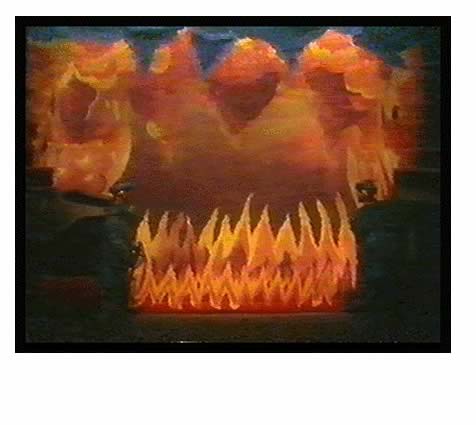TEACHING SESSION Staging
The Magic Flute - to
1. show designers' responses to the same text and encourage you to make
your own comparisons between staged examples, and between two-dimensional
and staged designs
2. outline the mythic content of the opera
3. show the balance of popular elements and esoteric elements within a
work of art, to look at the capacity of the work of art to convey several
levels of meaning
4. encourage you to see the work for yourself.
The
Magic Flute ,an opera in two acts, music by W.A.Mozart, libretto
by Emanuel Schikaneder. Commissioned by Schikaneder in 1791 for the first
night on September 30th. Composed the same year as an anonymous commission
for a Requiem which Mozart gloomily associated with his own superstitious
belief in imminent death. The Magic Flute was performed only weeks before
Mozart's death on December 5th.
PLOT SUMMARY
Act 1; Tamino,
a prince is saved from a serpent by three women who turn out to be attendants
of the Queen of the Night (see sheet of images). The latter promises him
her daughter Tamina to him if he rescues her from the wicked and malign
Sarastro (girls as prizes, again). Tamino agrees and departs with Papageno,
the Queen's bird catcher, and guided by three boys in a flying machine.
Pamina tries to escape but is recaptured by Monostatos, Sarastro's Moorish
servant. Papageno inadvertantly terrifies Monostatos, and Tamina actually
does escape. Tamino discovers that, far from being a tyrannical and evil
force, Sarastro is the fount of all wisdom and vitue. Pamina and Papageno
are discovered by Sarastro and try to flee. Tamino and Papageno are invited
to take the initiation trials of Sarastro's circle.
Act 2; The
initiates undergo four Trials
1. they are sworn to silence in a darkened room and resist the three attendants
of the Queen of the Night.
2. Papageno gives way in his vow of silence and chats to an old crone
but Tamino refuses to greet the grief stricken Pamina. Sarastro tells
the two men they have passed the first two trials. Papageno tells the
old crone he loves her truly and she is transformed into his perfect female
counterpart Papgena, before they too are forced to part.
3. The Trial of Fire ,
4. The Trial of Water , both of which Tamino passes through while playing
his magic flute, to finally enter Sarastro's temple. The lovers are thus
reunited, and a final plot to infiltrate Sarastro's temple by the Queen
of the Night and her attendants evaporates before the sunlight of wisdom
and truth shining around Sarastro, the lovers, the three boys and the
priests.
Thematic
Analysis
From the plot as written here you might assume the opera be fanciful,
a fairy tale (generous), or just plain daft. The curious reversal of the
roles and values of the Queen of the Night and Sarastro hinmts at something
more profound and resonant. The libretto is intensively set with Masonic
symbols and Jacques Chailly (see beneath) has revealed how immediate and
controversial were the references embedded within the Flute. The opera
can initially be seen as a journey of reconciliation from darkness to
light to celebrate the notion of Progress.
But a first
interpretation can be set out thus,
"The conflict in the Flute between the Queen and Sarastro for control
of the Circle of the Sun symbolises the conflict in Masonic lore between
the dualism proposed by inscriptions on the twin pillars of Hiram's Temple
of Solomon, which list varying opposing forces; masculine/feminine, sun/moon,
day/night, fire/water, gold/silver, etc." English National Opera
Guide, John Calder London 1983. Sarastro seeks to bring about in the union
of Tamino and Pamina a synthesis of warring elements that will bring about
a new Golden Age of Peace and Wisdom. Specifically, references in the
opera explore in an oblique way the contemporary controversy as to whether
women should be admitted as full members of the Masonic Order. There were
Lodges of Adoption for women ; items in their ritual included a serpent,
veils and a golden padlock, all of which appear in the opera.
Detailed
references to the minutae of Masonic lore can be found throughout, see
Jacques Chailly, The Magic Flute,Masonic Opera Gollancz London 1972, and
Paul Nettl, Mozart and Masonry , Da Capo, NY 1970 (Polytechnic Library,
780.92)
Designing
for the Flute
ABOVE A
scene from Hockney's staging.
EXERCISE
1
The staging of the appearence of the Queen of the Night (several versions)
1. version by the architect, Karl Frederick Schinkel see aquatint after
his drawing of The Queen of the Night (1816)
2. version by the set designer Simon Quaglio 1818, pen, watercolour.
3. version by David Hockney , 1978
4. version for Ingmar Bergman's staging. 1975
EXERCISE
2 Hockney's staging of key elements ; the beginning of Act 2, and a comparison
with Bergman's version
" There are so many ways you can interpret The Magic Flute. Even
though John Cox and I had discussed many possibilities. once I got into
the music I saw tended to see things my own way. John had thought about
Sarastro's kingdom as an ideal place a utopia, but I saw it more geometrically.
My concept was more abstract. It was a place of order and proportion and
I expressed those ideas in straight lines. Here's one example My set for
the beginning of Act2 is a symmetrical view of a palace garden that extends
intop deep space. The converging lines of the palm trees and the pyramid
in the distance give you that feeling. I suppose that if I had directed
it Sarastro and his followers would have been placed formally within that
framework to emphasise the set's perspective. But John actually wanted
them seated in a circle on the floor, because his vision of Sarastro's
kingdom was a kind of democracy." David Hockney (Hayward 1985)
"All things considered the most effective scenes were those in which
the action and the painted cloths were confined far downstage, carefully
lit from the front, and the whole aspired most nearly to the nature of
a picture in a frame..... The most unsatisfactory aspect of our Magic
Flute was the costumes, where David's eclecticism fell short of perfection
because it became difficult for him to know where to turn. "
" The Magic Flute which encouraged Hockney to think in terms of time
and space, also led him to regard his new work as a form of environmental
sculpture. But his painter's sensibility prevailed and the game of illusion
was much more challenging to him than mere verisimilitude. It was more
interesting to suggest endless space than to displace it with heavy volume."
Hayward 1985.
|















